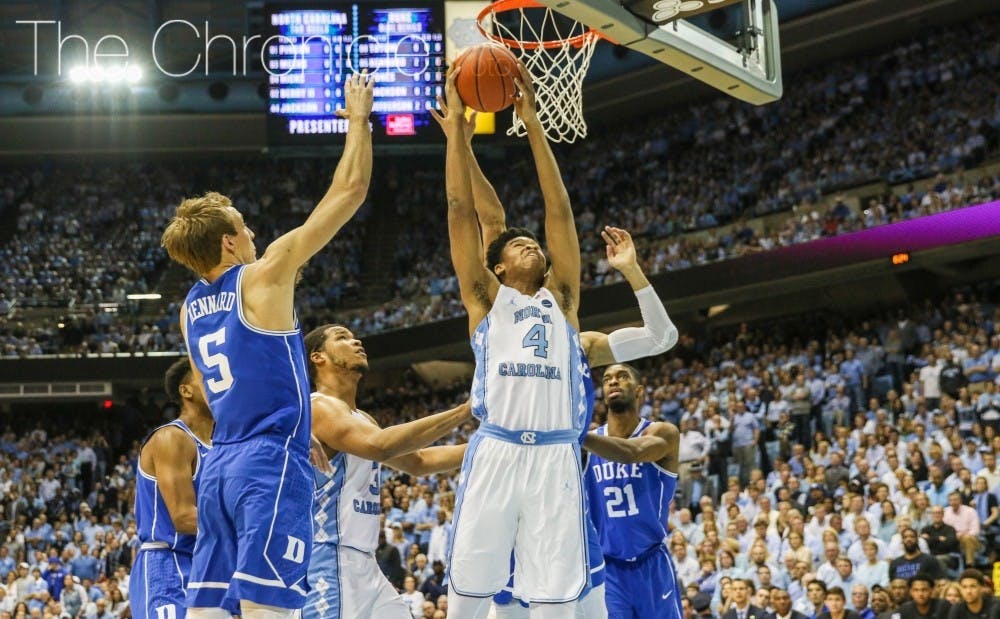Before the officials hijacked what was expected to be a riveting showdown between North Carolina and Gonzaga, one of the most eye-popping similarities between the teams was their size.
Many expected the Bulldog duo of Przemek Karnowski and Zach Collins to roam the floor and make the Tar Heels’ Isaiah Hicks and Kennedy Meeks look small. Yes, I did say Kennedy Meeks—all 260 pounds of him—and small in the same sentence.
But what made the title game so fascinating leading up to the contest and during the matchup was the diverse skillset among the big men.
For all the jokes about Meeks’ weight, the senior’s ability to fight on the glass is as good as anyone’s and without Meeks’ 25-point, 14-rebound performance against Oregon in the Final Four, North Carolina may not have made it to Monday. The Charlotte native then turned in a pedestrian box score performance against Gonzaga but made arguably the game’s biggest play when he blocked the Bulldogs’ Nigel Williams-Goss late.
On the other side of the court, Karnowski’s girth and mountain-man beard took some of the attention away from his knack for making smart passes from the high post and out of double teams. For a casual sports fan who watched only Monday’s contest, reading 1,000 words about a Polish man who routinely missed shots at the hoop seems insane. But I assure you, the play we saw from the 7-foot-1 center against the Tar Heels was far from the norm.
As Karnowski’s understudy, Collins may not have been a household name before the Big Dance, and foul trouble—code word for questionable officiating—limited the Las Vegas native’s impact in the title game. But the freshman rose up draft boards in March after showing a high level of mobility for a 7-footer and bringing physicality and toughness to both ends of the floor.
With the NBA entrenched in the floor-spacing, small-ball revolution and college basketball becoming more and more perimeter-oriented, the build-up to Monday night served as a reminder that the perception of a decline in the value of post players may be a bit overblown.
Yes, you need a standout ball handler to make a run into April, and yes, the 3-pointer is still the sport’s most valuable shot. But although the back-to-the-basket game that made the likes of Shaquille O’Neal and Hakeem Olajuwon dominant has faded, bigs that can fill a particular role can make the difference between a good and a great team.
As the players on the court play further away from the basket to fit today’s game, the difference between getting minutes or being glued to the bench for a big man could be his ability to rebound like Meeks or master the high-low pass like Karnowski.
For even younger post players, watching Gonzaga and North Carolina’s bigs rely on their old-fashioned physicality may have given them cause to pause. The best big men in high school have seen the changes in basketball and realized the path to a successful NBA career in the future almost certainly involves developing a mid-range or 3-point shot.
Last Wednesday’s McDonald’s All-American game was perhaps the clearest example of this trend. DeAndre Ayton—an Arizona commit and second-ranked high school senior in the country—and No. 5 overall prospect Mohamed Bamba combined to take and miss five 3-pointers despite having YouTube highlight videos primarily filled with uncontested dunks against over-matched high school players.
Duke commit Wendell Carter Jr.—one of five players in the top 10 of the Class of 2017 designated as a power forward or center—has also worked to expand his range, and as time goes on, one should expect a substantial number of bigs to come to college with some semblance of a jump shot.
But in the meantime, the play of both Gonzaga and North Carolina’s post players should serve as a reminder that post players are still crucial in today’s perimeter-oriented game.
In many ways, the Blue Devils have seen what the consequences of not having enough quality bigs can be in the biggest moments. A year ago, Duke was almost entirely dependent on center Marshall Plumlee to carry them down low, as Chase Jeter struggled to make the adjustment to the college game.
Despite coming into this season with more options on paper, the Blue Devils fell victim to the same problem once again as the team ran out of answers after graduate student Amile Jefferson. Although no two seasons are alike and other factors contributed to both disappointing finishes, the perimeter-oriented Duke teams were eerily similar in their frailty down low.
Yet, it’s hard to say these struggles for the Blue Devil bigs were surprising. Outside of Kentucky’s NBA factory, post players take longer to develop than their smaller counterparts. Karnowski averaged a measly 5.4 points per game as a freshman, and Meeks struggled with criticism from his own head coach.
Collins may be an exception, but even he had stretches this season when he was held in check by opponents and did not always play heavy minutes because of his team’s frontcourt depth.
At the end of the day, college basketball has shown that doing due diligence to either develop or recruit multiple big men with skillsets that complement the players around them can pay major dividends. As North Carolina celebrates its sixth national championship in program history, the Tar Heels made a statement about the lasting importance of the biggest players on the court.
Get The Chronicle straight to your inbox
Signup for our weekly newsletter. Cancel at any time.

